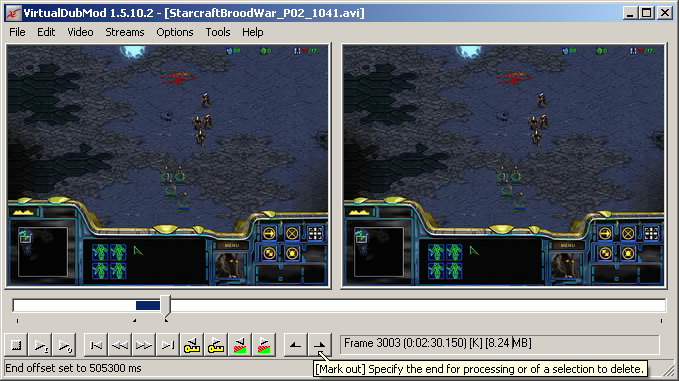Difference between revisions of "Splitting / Appending"
From SDA Knowledge Base
Ballofsnow (Talk | contribs) (Splitting with vdub done.) |
Ballofsnow (Talk | contribs) (Split with YAMB) |
||
| Line 35: | Line 35: | ||
<font color="green"><b>Tip:</b> You can navigate through keyframe placements by pressing the button with an arrow and a yellow key under it.</font> | <font color="green"><b>Tip:</b> You can navigate through keyframe placements by pressing the button with an arrow and a yellow key under it.</font> | ||
| + | |||
| + | <br> | ||
| + | ===With YAMB 1.6=== | ||
| + | |||
| + | YAMB 1.6 is limited in that you can't see the video, so you have to pick out where you want to make your cuts beforehand. It also only accepts input in time format, not by frames. You have the option of splitting by duration, by range and by size. | ||
| + | |||
| + | Splitting is simple enough: | ||
| + | * Click the Splitting & Joining tab | ||
| + | * Load your video. | ||
| + | * Input the values. | ||
| + | * Split it! | ||
| + | |||
| + | <br> | ||
| + | <font color="red"><b>The drawback:</b></font> Same as with VirtualDub(Mod), unfortunately. | ||
| + | |||
| + | <br> | ||
| + | ==Appending== | ||
| + | |||
| + | The act of joining multiple videos together to create one video. | ||
Revision as of 15:36, 2 June 2007
Introduction
The goal of this guide is to show ways to split or append videos without having to re-encode. There are inherent drawbacks which will be explained, as well as solutions to get around most of them.
Tools
- VirtualDubMod - for avi files.
- YAMB - for mp4 files.
- AviSynth
- Codec
- FFDShow
Splitting
The act of taking a video and creating smaller, separate videos.
With VirtualDubMod
- Use the slider and the two arrow buttons next to the frame number to make your selection.
- Video -> Direct Stream Copy.
- File -> Save As.
The drawback: You can only start a cut on an I frame. In VirtualDub(Mod) this is labeled with the letter K which can be seen at the bottom center of the interface. This has to do with how videos are compressed.
Without going too in depth... you start with a full I frame followed by a sequence of P or B frames. Those P and B frames are based off that previous I frame. They ABSOLUTELY NEED that I frame or they won't display correctly, so you wouldn't want to cut out that I frame, would you? What this means is that in VirtualDub(Mod), it doesn't matter where you make your starting selection, it will search backwards until it finds that K frame. So while you may think you're starting a cut on frame 3080, which happens to be a P frame, the cut may actually start on frame 2994, a K frame. The problem is that the spacing between K frames can be very far. The video I'm looking at while writing this guide has them spaced out every 10 seconds. This does not allow me to make a precise cut. The good thing is that this drawback doesn't apply to the end of your selection.
Summary: The start of your cut will not be precise (unless you knowlingly start off a K frame), but the end of your cut will be.
Tip: You can navigate through keyframe placements by pressing the button with an arrow and a yellow key under it.
With YAMB 1.6
YAMB 1.6 is limited in that you can't see the video, so you have to pick out where you want to make your cuts beforehand. It also only accepts input in time format, not by frames. You have the option of splitting by duration, by range and by size.
Splitting is simple enough:
- Click the Splitting & Joining tab
- Load your video.
- Input the values.
- Split it!
The drawback: Same as with VirtualDub(Mod), unfortunately.
Appending
The act of joining multiple videos together to create one video.
